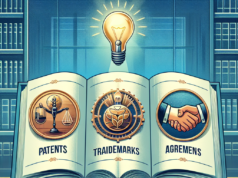
In an era where digital content consumption is at an all-time high, the landscape of media rights and content licensing is undergoing a seismic shift. As traditional models are challenged by innovative technologies and changing consumer behaviors, stakeholders in the media industry are re-evaluating their strategies to adapt to this new reality. This article delves into the evolution of content licensing, the key players shaping the industry, recent legal changes, technological advancements, successful case studies, and future trends that will define the next decade in media.
The Evolution of Content Licensing: A Historical Perspective on Media Rights
Content licensing has a rich history that dates back to the early days of broadcasting. Initially, media rights were straightforward, with networks acquiring content from producers for a fixed period. However, the advent of cable television in the 1980s introduced complexities, as multiple channels began vying for exclusive content. The rise of the internet in the late 1990s further transformed the landscape, leading to the emergence of streaming platforms that disrupted traditional distribution models. Today, content licensing encompasses a myriad of agreements, including syndication, co-production, and digital rights management, reflecting the diverse ways in which content is consumed and monetized.
Key Players in the Media Landscape: Who’s Shaping Content Licensing Today?
The current media landscape is dominated by a mix of traditional players and new entrants. Major studios and networks, such as Disney, Warner Bros., and NBCUniversal, continue to hold significant sway over content licensing, leveraging their extensive libraries and brand recognition. However, the rise of streaming giants like Netflix, Amazon Prime Video, and Disney+ has shifted the balance of power, as these platforms invest heavily in original content and exclusive licensing deals. Additionally, tech companies like Apple and Google are increasingly entering the fray, utilizing their vast user bases and technological capabilities to reshape content distribution. This dynamic interplay among various stakeholders is driving innovation and competition in the content licensing arena.
Recent Legal Changes Impacting Content Licensing: What You Need to Know
Recent legal developments have had a profound impact on content licensing practices. Notably, the implementation of the Digital Millennium Copyright Act (DMCA) has provided a framework for addressing copyright infringement in the digital age, but it has also raised questions about fair use and the responsibilities of platforms hosting user-generated content. Additionally, ongoing discussions around international copyright treaties, such as the Marrakesh Treaty, aim to enhance access to copyrighted works for individuals with disabilities, further complicating licensing agreements. As legal frameworks continue to evolve, media companies must stay informed and agile to navigate the complexities of content rights and ensure compliance.
Innovative Technologies Transforming Content Licensing Practices and Strategies
Technological advancements are revolutionizing content licensing practices, enabling more efficient and transparent processes. Blockchain technology, for instance, is being explored as a means to create immutable records of ownership and licensing agreements, reducing disputes and enhancing trust among stakeholders. Artificial intelligence (AI) is also playing a crucial role, with algorithms capable of analyzing viewer preferences and predicting content performance, thereby informing licensing decisions. Furthermore, data analytics tools are empowering media companies to optimize their content strategies by providing insights into audience behavior and engagement. These innovations are not only streamlining licensing processes but also fostering new business models that prioritize flexibility and responsiveness.
Case Studies: Successful Content Licensing Models in the Digital Age
Several companies have successfully navigated the complexities of content licensing in the digital age, serving as models for others in the industry. For example, Netflix has pioneered a subscription-based model that allows users unlimited access to a vast library of content, while simultaneously investing in original programming to reduce reliance on third-party licenses. Similarly, Spotify has transformed music licensing by negotiating direct deals with artists and record labels, enabling a more equitable revenue-sharing model. Another notable case is the collaboration between Hulu and various networks, which has resulted in a unique hybrid model that combines ad-supported and subscription-based content. These case studies illustrate the diverse approaches to content licensing that are emerging in response to changing consumer preferences and technological advancements.
Future Trends in Content Licensing: Predictions for the Next Decade in Media
Looking ahead, several trends are poised to shape the future of content licensing over the next decade. First, the continued rise of direct-to-consumer models is expected to challenge traditional distribution channels, prompting media companies to rethink their licensing strategies. Second, as global content consumption increases, there will be a growing emphasis on localization and regional licensing agreements to cater to diverse audiences. Third, the integration of augmented reality (AR) and virtual reality (VR) into content experiences will necessitate new licensing frameworks to address the unique challenges posed by immersive media. Finally, sustainability will become a key consideration, with companies increasingly seeking to align their licensing practices with environmental and social responsibility goals. These trends indicate a rapidly evolving landscape that will require adaptability and foresight from all stakeholders involved.
The media landscape is in the midst of a transformative period, driven by technological advancements, shifting consumer behaviors, and evolving legal frameworks. As content licensing continues to adapt to these changes, stakeholders must remain vigilant and innovative to thrive in this dynamic environment. By understanding the historical context, recognizing key players, navigating legal complexities, leveraging technology, learning from successful models, and anticipating future trends, media companies can position themselves for success in the ever-evolving world of content licensing.

























